
Chapter 7
EARLY WASHINGTON STATE GYMNASTICS HISTORY
In 1897 the AAU recognized Gymnastics as a sport. Therefore it is possible that gymnastics was beginning in Washington State by that time. It is known that in 1916 the German Turnvereins, located in downtown Seattle, had a gymnastic program. Other organizations, which had programs at this time included the Seattle YMCA, the Elks Club and The Sokols. Throughout the state, exhibition teams were formed to develop enthusiasts. Gymnastic competitions were held after the turn of the century. (11)
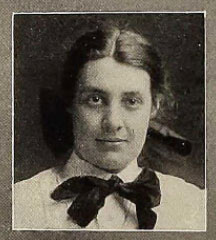 Mabel Georgene Furry, A.B. (UW 1911) attended the Harvard Summer School of PE in 1916. Dudley Sargent was the originator of these summer school sessions and he was instrumental in the formation of Physical Education in this country in the late 1800’s and early 1900's. Miss Furry was the PE teacher at Queen Anne High School in that year. (This information was found in the 1916 attendance brochure printed for the Harvard course.) Further info on Miss Furry - born May 28,1890, Seattle WA. and died in Sept.1966, Seattle, WA. According to the 1930 census, Mable, aged 39 lived with her mother Laura at 1217 2nd Ave. North, Seattle and listed as a public school teacher. The 1954 directory had Mabel still living at the residence and she was still a teacher. (photo from UW Tyee yearbook 1911) Read more about Mabel, including articles from across the country concerning her 1916 Harvard success. click here
Mabel Georgene Furry, A.B. (UW 1911) attended the Harvard Summer School of PE in 1916. Dudley Sargent was the originator of these summer school sessions and he was instrumental in the formation of Physical Education in this country in the late 1800’s and early 1900's. Miss Furry was the PE teacher at Queen Anne High School in that year. (This information was found in the 1916 attendance brochure printed for the Harvard course.) Further info on Miss Furry - born May 28,1890, Seattle WA. and died in Sept.1966, Seattle, WA. According to the 1930 census, Mable, aged 39 lived with her mother Laura at 1217 2nd Ave. North, Seattle and listed as a public school teacher. The 1954 directory had Mabel still living at the residence and she was still a teacher. (photo from UW Tyee yearbook 1911) Read more about Mabel, including articles from across the country concerning her 1916 Harvard success. click here
An unnamed gentleman who was a circus performer with Ringling Brothers set up gymnast equipment in a vacant lot near his house in the 1930's and had a great influence on the young men in that area. He set up his equipment on the corner of 98th street just off of 5th Ave. NW. One of the boys he influenced, Gifford Owens, went on to become a catcher for the Ringling Brothers Circus. (11)
The Green Lake Fieldhouse had exhibitions in those early years and competitions were held at the Seattle YMCA. The AAU, from 1936-1941, held the Pacific Northwest Championships in Vancouver, B.C. There were three levels of competition - novice, junior and senior. (11)
Lou Bates was an early director of physical education at the Seattle YMCA and supported the growth of gymnastics in this state. (11)
Roosevelt High School had a gymnastics exhibition team due to the expertise of their staff. Roosevelt High opened in 1922 and Sheridan (Sherry) Berthiaume (April 8, 1886 - July 27, 1961) who had been Physical Education director at the Seattle YMCA started a tumbling class and some gymnastics there. In 1936 Louis Hull took over this program and continued it until 1970. This tumbling class was coed. There were no competitions, but there were exhibition shows and half-time performances at games.
During the 1920's and until World War II, the Seattle YMCA held open gymnastics meets at various cities around the state and in Canada. Some meets were held in Seattle in 1932, in Everett in 1934, and Vancouver, B.C. in 1939 and 1940. Participants came from Everett, Bellingham, Spokane, Vancouver, Tacoma, and Vancouver, B.C. From 1932-39 the Seattle YMCA sponsored a state high school invitational meet. These meets were discontinued at the beginning of World War II. (11)
Clive Green, while a student at the University of Washington, worked at the Seattle YMCA from 1939-42 and helped coach gymnastics. After the war he went to work for the Yakima YMCA and had a long-time program there. In 1931 and 1932 Thor Erickson of the Bremerton YMCA and Al Hodges of the Tacoma YMCA helped develop an interest in gymnastics in those cities. (11)
"Augie" Auernheimer participated in early Seattle Turnverein programs. These programs still emphasized heavy equipment and formal physical educational activities (11). If you notice through the American physical education evolution, there was a big push for the use of heavy equipment until later in the 1800’s. At that time, the philosophy was changing and new movements came in that emphasized “light gymnastics” that was basically calisthenics. "Augie" was a graduate of the Normal College of American Gymnastics in Indianapolis, Indiana - a Turnverein oriented training school. He was the first man to formally promote the sport of gymnastics at the University of Washington. (11)
Jim Hicks worked for the Portland YMCA from 1936-40 and influenced the development of gymnastics in the Vancouver area. In 1942 he went to work for the Vancouver Public Schools and was also City Recreation Director. He formed exhibition teams primarily in tumbling and trampoline. He also took various individuals to The National AAU Championships in New Jersey in 1943. One of his entrants was second in the tumbling event. His students also performed in a popular movie of the late 40's. (11) (“Till The Clouds Roll By” with Dinah Shore, Judy Garland and Frank Sinatra. It has a short clip of acrobats in a circus number!)
Russell Utley and Earl Willits were also early performers during these pre-war years. They did hand balancing and juggling acts.
Jack Henderson and Paul Hurd did trampoline exhibitions at UW during these years and then they joined the Navy for the War effort. They both came home to continue in gymnastics, Paul to coach, and Jack to work at the Fauntleroy YMCA in West Seattle. (11)
During the war all competition halted. Louis Hull, however, at Roosevelt High School kept his exhibition teams going. (11)
Standardization of equipment did not occur until after the war. Equipment was brought out of storage, instructors began to organize programs, and gymnastic enthusiasts increased rapidly. The first post war competition was an open meet held at the Seattle "Y" in 1947 and was conducted by George Lewis. (11)
Hubie Dunn, from Illinois, came to Washington State University in 1947 and started the gymnastics program. He is considered one of the great Washington pioneers of gymnastics in his influence in men’s gymnastics and his production of many coaches for men and women’s gymnastics. He held the first men’s collegiate meet in this state, in 1948.
THE SEATTLE YMCA
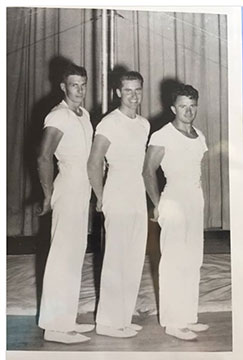 Under the direction of George Lewis who began volunteer work at the Seattle YMCA from 1939-42. When George returned from the service during WWII, he went back to the “Y” where he trained himself and hoped to interest other men, including Tommy Thorson, in working on the apparatus. Since he always enjoyed teaching others, he had classes for young people. The first competitive open meet after the war was in 1947 and was conducted by George Lewis.
Under the direction of George Lewis who began volunteer work at the Seattle YMCA from 1939-42. When George returned from the service during WWII, he went back to the “Y” where he trained himself and hoped to interest other men, including Tommy Thorson, in working on the apparatus. Since he always enjoyed teaching others, he had classes for young people. The first competitive open meet after the war was in 1947 and was conducted by George Lewis.
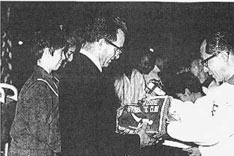 (left: George Lewis and Lonna Woodward from the “Y”. At right, George is on the far right in the photo)
(left: George Lewis and Lonna Woodward from the “Y”. At right, George is on the far right in the photo)
In 1950 Eric Hughes brought one of his students, Rudy Peterson, to compete at a gymnastic meet at the “Y” and that is where Eric and George met. Thereafter they did hand balancing together and performed at shows in order to further interest in the sport.
Eric had a childrens programs but he was only able to accommodate boys at his UW facility so when he got calls to teach girls, Eric referred them to George Lewis at the downtown “Y”. Thus George started with the girls programs. The first of these girls was Patsy Walkup beginning in about 1957. Also included were the Suver girls, Ann Berger along with Terry Hildebrand, Frank Gato, Ken Lombardo, and Dale Shirley. This group of people would train at the Seattle “Y” on Wednesdays and apparently would also go to UW.
Dale McClements began in 1959 as a student at Highline High School, then she went to Gym Kamp that summer, then to the “Y” with George and often to California with Bud Marquette.
The program at the Seattle “Y” attracted many high school Physical Education teachers and the generous sharing that George gave to the sport of gymnastics especially to the girls. He gave workshops, invitational meets and helped them go to other meets and invited them to workouts at the YMCA.
THE PENINSULA
The Bremerton YMCA was an early program on the Kitsap peninsula. The coach was Frank Perrone, who later had a program at the old Bremerton Armory. It was known as the Kitsap County Tucks.
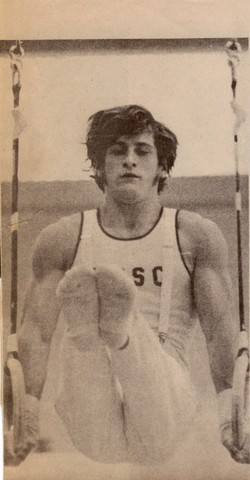 Frank Royal Perrone, June 29, 1951 - Feb. 25, 2013
Frank Royal Perrone, June 29, 1951 - Feb. 25, 2013
(Kitsap Sun Obit: "Frank grew up in Bremerton, where he was an active athlete from childhood through college. He graduated from West High School in 1969 where he lettered in wrestling and gymnastics. He went on to attend Central Washington University and earned a BA in education. While at CWU he qualified for the NAIA Championships. He was CWU's first national gymnastics champion. At the competition, he was a four event All American in two days, earning the title of Outstanding Gymnast of the tournament. He went on to coach girls gymnastics through Kitsap County YMCA Tucks. Over a several-year period he successfully held Class One and Class Two level meets which opened doors for several gymnasts to compete at national competitions. After coaching gymnastics, he moved to Arizona and worked in construction for many years. Frank inspired the athletes he coached to strive for perfection. He developed friendships in the same way that he coached and will be missed by all."
John Smith recalls: "Perrone, who ran Kitsap County Tucks for years and held the Whaling Days outdoor gymnastics competition for a number of years downtown on the waterfront, in conjunction with city celebration of Whaling days. We first attended the meet in 1983 and had a ball. Frank produced a number of regional competitors at Class 2 and Class 1 and he hosted the optional state meet at his gym in Silverdale in the mid 80's. He had a green plastic cover for his floor exercise mat and it was pretty strange but we made it work. Frank married one of his gymnasts and they had some kids together and he was an engine mechanic and lived in Bremerton. "
A community gymnastics program through the Clallam County Family YMCA was established in Port Angeles in 1980. It began as a seasonal intramural program for middle school girls and has expanded into a year round program offering pre-school, recreational and girls competitive programs.
Valley Gymnastics in Port Hadlock was the other private club on the Olympic Peninsula that was in operation in about the early 1990’s. A teacher by the name of Becker ran a small tumbling program in Clallam Bay for many years until his retirement. Small recreational programs have also operated off and on in Forks. Chrissy Hawkinson was running a small program through the Grays Harbor YMCA in Hoquiam in the early 2000’s. There was a new small club at Ocean Shores also in the early 2000’s until around 2014.**
Jim Holt notes that Washington Gymnastics Academy from Seattle had a satellite gym in Silverdale for two years and ran a parks program up at Jefferson County fairgrounds for a year.
THE HUSKY GYMNASTICS CLUB
UW students who were interested in gymnastics formed this club in 1954. It became inactive for a few years after the 1956 start of the UW Men’s Varsity Team. It was revitalized in 1961 and was open to all individuals and for graduate students. It mainly was used in exhibitions while the UW team did the competitions.
SEATTLE GYMNASTICS CLUB
The men on the UW team and the girls from the “Y” formed the Seattle Gym Club. Their purpose was to put on shows at various high schools in order to make money for them as well as sharing half with the school host.
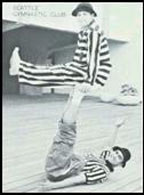 (left: Seattle Gym Club comedy tumbling act of Bo Bennett and Jim David.)
(left: Seattle Gym Club comedy tumbling act of Bo Bennett and Jim David.)
The Club was founded on Nov. 5, 1961 to promote gymnastics in Western Washington, and to raise money to send club members to National Gymnastics meets, and to the Olympic trials, clinics and on tours. In 1966 the New Zealand National team was brought to Seattle. In 1967 a team from Kobe, Japan was brought over, and in 1968 a team from Germany was sponsored. The Club was composed of members from a number of different clubs. It was not created to take members from other clubs, but rather to supplement the other clubs by bringing together high quality gymnasts for exhibitions and competitions. This club did exhibitions in schools and the community. The club itself did not enter teams in competition, but rather members competed for their own individual teams. Most of the girls competed for the Seattle YMCA, which won the National “Y” meet three years in a row in the 1960’s. Most of the men competed on the UW men’s team.
Under the direction of Dr. Eric Hughes, this group, at the time, was made up of current and former UW men’s and women’s gymnastic team members. It toured Asia in 1968 and included: Yoshi Hayasaki, Bo Bennett, Jim David, Bob Hall, Mike Flansaas, Charles Peters, Gunter Bohrmann, Jean Henderson, Carol Elsner, Barbara Cook, Linda Bennett, Pauline David and Peggy Rowen.
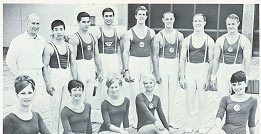
1968 Seattle Gymnastics Club. (Back row, L. to R.) Dr. Eric Hughes, Yoshi Hayasaki, Bo Bennett, Jim David, Bob Hall, Mike Flansaas, Charles Peters, Gunter Bohrmann. (Front row) Jean Henderson, Carol Elsner, Barbara Cook, Linda Bennett, Peggy Rowen.
In September of 2015, Eric Hughes recalled the 1968 Philippines tour. Imelda Marcus gave him a tour of her house. During the Taiwan trip, there were protesters and while the gymnasts were doing their exhibition, they were locked into the exhibition hall. They could hear the protesters pounding on the doors!
During the 1970 trip to Bolivia, Gunter Bohrman and the UW team toured. It was not a pleasure trip by any means. Eric said, "We worked!" They tried to take a day trip to Lake Titicaca to the ruins. They were staying at a military college and they all boarded the military bus. There was, of course, a revolution going on and they traveled up to 15,000 feet and were going across a plateau. They were stopped at a blockade and the interpreter told Eric to go out and talk to the soldiers. Eric got off the bus and immediately had a machine gun in his belly. Eric explained that they were a gymnastics exhibition group and that they wanted to see the ruins. Finally the soldier said he would let them continue, but that there was another checkpoint five miles ahead and they might not be so nice. They turned around and headed back to the college. He mentioned that 13 year old Peggy Rowan was with on the trip and he was given power of attorney while she was on the trip. She was the main reason he felt he needed to turn the bus around. He said Peggy was such a good gymnast they wanted to take her on the trip.
BOYS GYMNASTICS
High school programs for boys grew in the 1950’s until its demise in the early 1980’s. Club gymnastics is still very much alive in our state having produced such gymnasts as Geoffrey Howell, Brett McClure, Jeff Johnson and Sergio and Daniel Luna.
GIRLS GYMNASTICS
The late 1960’s saw the beginning of girl’s high school and college teams. 1973 saw the big increase of girl’s club gymnastics as a result of the 1972 Olympics and Olga Korbut impact. Club, junior high and high school gymnastics is very vital in Washington in the early 2000’s with over 55 club programs.
FROM AN INTERVIEW WITH MARY SARVER concerning early WA Gymnastics memories.
(From the summer of 2002)
Mary Sarver graduated from Western Washington University in 1955. She went to Denmark to a Gymnastic Folk High School and then came back to Washington to Highline Junior High and worked with Ev Woodward in gymnastics. She taught at Highline HS 1958-59, and had the first high school team which competed in Canada in the 1959 AAU competition.
Mary went to the Seattle “Y” for coaching help from George Lewis. She put on clinics and workshops and was an instructor and co-director of Gym Kamp. She attended the first National Gymnastics Conference and also contributed to the first High School Gymnastic Guide Book; she wrote the “Beam” section of Eric Hughes' 1963 book Gymnastics for Girls. Inducted into the WIAA Hall of Fame in 1998 and the USAG WA Hall of Fame in 2004 along with her husband Bob.
Mary commented on some of the Washington gymnastics pioneers:
“Chuck Thout was from Kennewick and he was on the same gymnastics team as Hubie Dunn in Illinois.” (Mary’s husband, Bob, did his masters at WSU under Hubie.)
“Tommy Thorson coached with George at the “Y”. He had also been gymnast. Carolyn and Gwen Suver from the 1950’s: their mother went to gym camp also, and taught hula dancing. I came in 1957. The Suver sisters were training with Ev Woodward. They were at Highline and went to gym camp. Carolyn married Frank Hailand who was a UW grad assistant and assistant coach for a year - an Illinois gymnast. Patsy Walkup was one of the first of George’s girls. Also worked with Eric.”
Ev Woodward was at Highline before the Sarvers. Bob took over Ev’s coaching job in 1958. Bob went to college at George Williams in Chicago, which was a YMCA school. He learned gymnastics under Bud Beyer. ("Bud Beyer was considered to be one of the finest AA gymnasts of his era. He would have been a serious contender for the 1940 Olympic Team had not WWII interfered. In 2002, he was named an Honorary Member of the 1940 U.S. Olympic Team by a select group of Hall of Fame Honorees." http://www.usghof.org/files/bio/e_beyer/e_beyer.html )
Bob's first job was at the Tacoma “Y”, mostly working with the swim team. He didn’t like having to go out and get money for the team for the “Y” so he left and went to UW to get his teaching certificate. He helped coach at UW with Eric while he was there. Then he taught at Renton High. (Rex Davis came later to Renton.) After coming back from Denmark, Mary taught in a junior high school. Her mentor in college was then a principal who got her the job. She met Ev who was having gymnastics turnout at the high school with the early gymnasts. (1957) She went and worked with them at Highline the next year. Mary went to summer school up in Bellingham to get her 5th year. She came back expecting to work with Ev. In the meantime, Ev had gone on to the Seattle U. She was pretty mad at him! (Ev Woodward was from Texas.)
Bob was hired to replace Ev in 1958, and she fell for him. Mary had learned folk dancing up in Bellingham. She spent about four nights a week dancing in Seattle, because there was “so much good dancing there”. Bob had had ballroom dancing (Arthur Murray down in Tacoma), and Mary took him dancing when she found out he knew how to do the Cha-Cha. They danced all that year, and were married the next year. (1959) Gym Kamp, also known as Camp Waskowitz, was started the summer of 1958 with Ev Woodward, Eric Hughes, Jack Mackenroth and Bob Sarver the first year. Mary went the next year. Hubie Dunn suggested to Mary and Bob to get into photo cinematography, so they went to Pullman for two summers doing photography. They got to know Hubie very well and stayed in contact through the years.
"Carol Camp did well – Highline gymnast. Was set to go train nationally but fell on bars and hurt her back and was in a cast. Took ballet because she could still use her legs. Married the Norway UW gymnast Eigel Flaathen. Carol did Irish Step Dancing as a competitor and they still live in Norway."
National competitor Avis Tiebler “was gorgeous on the beam – you couldn’t keep your eyes off her.” *** She came here to work with George, like Doris Fuchs. Not unlike the gymnasts of today who travel to another state to work with a coach.
Bibliography
11.The Crimson and The Gray: 100 Years With The WSU Cougars. Pullman, WA. Washington State University Press. Fry, R.B., 1989.
13. History of Men's Competitive Gymnastics in The State of Washington
1971 Master's Thesis by Robert Joseph Bosse. University of Washington.
*information gleaned from Lee’s conversations with Eric Hughes.
**Information regarding the Peninsula provided by Jan Urfer.
***quote from Mary Sarver
Previous Chapter
Next Chapter
History Home Page
NAWGJWA
USAGWA